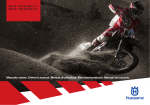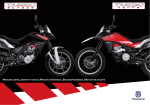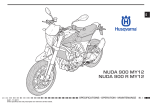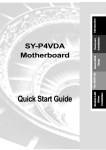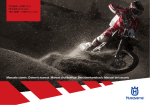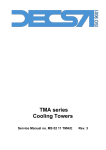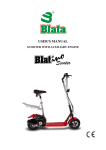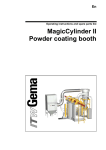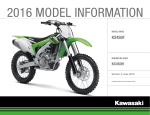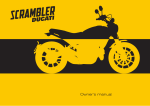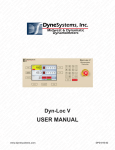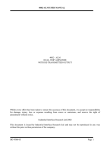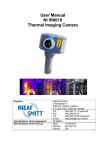Download TC - TE 449 2013 I.E. TE
Transcript
EN TXC TE TC TC - TE 449 2013 I.E. TE - TXC 511 2013 I. E. Ed. 03-2012 - Rev. 00 Unless specified, data and prescription are referred to all the models. SPECIFICATIONS - OPERATION - MAINTENANCE EN - 1 SUMMARY Page PRESENTATION.............................................................3 IMPORTANT NOTICES....................................................3 INTENDED USE..............................................................4 IDENTIFICATION DATA...................................................5 TECHNICAL DATA...........................................................6 TABLE FOR LUBRICATION, SUPPLIES...............................7 MOTORCYCLE OVERALL VIEW - TE...................................8 MOTORCYCLE OVERALL VIEW - TC - TXC.........................10 CONTROLS..................................................................12 RIDING........................................................................19 APPENDIX...................................................................51 PRE-DELIVERY INSPECTION..........................................52 ALPHABETICAL INDEX..................................................53 SCHEDULED MAINTENANCE........................... APPENDIX A Note lReferences to the “left” or “right” of the motorcycle are considered from the point of view of a person facing forward. lZ: lA: AUS: B: BR: CDN: CH: D: E: F: FIN: GB: I: J: USA: number of teeth Austria Australia Belgium Brazil Canada Switzerland Germany Spain France Finland Great Britain Italy Japan United States of America l Unless otherwise specified, all the data and the instructions are referred to any and all Countries. EN - 2 SPECIFICATIONS - OPERATION - MAINTENANCE IMPORTANT NOTICES 1) TC - TXC models are designed for RACING use, and guaranteed free from operating faults; the recommended maintenance table for racing use can be found in Appendix A. 3) All the motorcycles and any of their parts used in competitions of any type are excluded from the warranty. 2) TE models are designed for ROAD use, guaranteed free from faults, and covered by legal warranty provided that NO CHANGE IS MADE TO THE STANDARD SETTING and that the intervals specified on maintenance table of Appendix A are complied with. TXC TC TE SPECIFICATIONS - OPERATION - MAINTENANCE EN - 3 EN PRESENTATION Welcome to the Husqvarna motorcycling Family! Your new Husqvarna motorcycle is designed and manufactured to be the best in its field. The instructions in this book have been prepared to provide a simple and understandable guide for your motorcycle’s operation and care. Follow the instructions carefully to obtain maximum performance and your personal motorcycling pleasure. Your owner’s manual contains instructions for owner care and maintenance. The main repair or maintenance work requires the attention of a skilled mechanic and the use of special tools and equipment. Your Husqvarna Dealer has the facilities, experience and original parts necessary to properly render this valuable service. This “Owner’s Manual” is part and parcel of the motorcycle, hence, it shall remain with the motorcycle even when sold to another user. This motorcycle uses components designed thanks to systems and state-of-the-art technologies which are thereafter tested in competitions. In racing motorcycles, every detail is verified after each race in order to always guarantee better performance. To ensure trouble-free operation of the vehicle, it is necessary to follow the maintenance and inspection table found under Appendix A. IMPORTANT In order to maintain the vehicle’s “Guarantee of Functionality”, the client must follow the maintenance programme indicated in the user’s manual by carrying out maintenance inspections at authorised HUSQVARNA dealers. The cost for changing parts and for the labour necessary in order to comply with the maintenance plan is charged to the Client. NOTE: the warranty is NULL AND VOID if the motorcycle is rented. Important Notice Read this manual carefully and pay special attention to statements preceded by the following words: WARNING*: Indicates the possibility of severe personal injury or death if instructions are not followed. CAUTION*: Indicates the possibility of personal injury or vehicle damage if instructions are not followed. Note*: Gives helpful information. WARNING*: Never attempt to start or operate your motorcycle unless you are wearing appropriate protective clothing. Always wear a motorcycle helmet, boots, gloves, goggles and other appropriate protective clothing. PRECAUTIONS FOR CHILDREN WARNING l Park the vehicle where it is unlikely to be bumped into or damaged. Even slight or involuntary bumps can cause the vehicle to tip over, with subsequent risk of serious harm to people or children. l To prevent the vehicle from tipping over, never park it on soft or uneven ground, nor on asphalt strongly heated by the sun. l Engine and exhaust pipes become very hot during riding. Always park your motorcycle where people or children can not easily reach these parts, in order to avoid serious scalds. Parts Replacement When parts replacement is required, use only Husqvarna ORIGINAL parts. WARNING*: After a crash, inspect the motorcycle carefully. Make sure that the throttle, brake, clutch and all other systems are undamaged. Riding with a damaged motorcycle can lead to a serious accident. EN - 4 SPECIFICATIONS - OPERATION - MAINTENANCE INTENDED USE This motorcycle has been manufactured so as to withstand the standard Offroad stresses. Nevertheless, it is not suitable for use under the following conditions: - prolonged use at a steady speed; - prolonged use with fully-opened throttles; - use with luggage; WARNING* riding the motorcycle for more than two consecutive minutes with fully-opened throttles could cause engine damage, with consequent faults storage inside memory. Any warranty claim for engine damage caused by too high engine revs will be rejected by HUSQVARNA MOTORCYCLES S.R.L. TE 449 ZKHA600AADV000001 (l) (▲) (♦) EN IDENTIFICATION DATA The engine identification number is stamped at the top of the crankcase, while vehicle serial number is stamped on the frame steering tube. Always quote the number stamped on the frame when ordering spare parts or requesting further details about your vehicle and note it on this booklet. 1 TE 511 CHASSIS NUMBER ZKHA601AADV000001 (l) (▲) Vehicle identification number (V.I.N.) The full 17-digit serial, or Vehicle Identification Number, is stamped on the steering tube (R.H. side). (l) (▲) (♦) = Model designation = Model Year (2013) = Progressive no. (♦) TE 449 USA ZKHKEEFM#DV000001 (l) (▲) (♦) 2 TC 449 TE 511 USA ZKHA600AADV050001 (l) (▲) (♦) TC 449 USA ZKHKEEGM#DV000001 (l) (▲) 1. Chassis serial number 2. Engine serial number (♦) TXC 511 USA ZKHTC443#DV000001 (l) (▲) (♦) ZKHTX510#DV000001 (l) (▲) (♦) SPECIFICATIONS - OPERATION - MAINTENANCE EN - 5 TECHNICAL DATA ENGINE Type. . . . . . . . . . . . . . . . . . . . . single cylinder, 4 stroke (TE - TXC) Liquid cooling with double radiator and electric fan (TC) Liquid cooling with double radiator TC-TE 449 Bore. . . . . . . . . . . . . . . . . . . . . . . . . . 3.86 in (98 mm) Stroke. . . . . . . . . . . . . . . . . . . . . . . . 2.35 in (59,6 mm) Displacement . . . . . . . . . . . . . 27.44 cu. in (449,6 cm3) (TC) Compression ratio. . . . . . . . . . . . . . . . . . . . . . 13:1 (TE-TXC) Compression ratio. . . . . . . . . . . . . . . . . . . 12:1 TE-TXC 511 Bore. . . . . . . . . . . . . . . . . . . . . . . . . 3.98 in (101 mm) Stroke. . . . . . . . . . . . . . . . . . . . . . . . 2.35 in (59,6 mm) Displacement . . . . . . . . . . . . . . 29.14 cu.in (477,5 cm3) Compression ratio . . . . . . . . . . . . . . . . . . . . . . . . . 12:1 Starting . . . . . . . . . . . . . . . . . . . . . . . . . . . . . . . electric Type of fuel. . . . . . . . . . . . . . unleaded fuel 95ROZ/RON TIMING SYSTEM Type. . . double overhead camshaft chain operated; 4 valve Valve clearance (with engine cold) Intake. . . . . . . . . . . . 0.008 ÷ 0.01 in (0,20 ÷ 0,25 mm) Exhaust. . . . . . . . . . 0.011 ÷ 0.013 in (0,30 ÷ 0,35 mm) LUBRICATION Type. . . . . . . . . . . . . . . . wet sump with two lobe pumps and cartridge filter IGNITION Type. . . . . . . . . . Capacitive discharge electronic system with adjustable advance (digital control) Spark plug type . . . . . . . . . . . . . . . . . . “NGK” CR 9EKB Spark plug electrode gap . . . . . . . . . 0.028 in (0,7 mm) FUEL SYSTEM Type. . . . . . . . . . . . . . . . . . . . . Electronic injection feed PRIMARY DRIVE Drive pinion gear . . . . . . . . . . . . . . . . . . . . . . . . . . Z 32 Clutch ring gear . . . . . . . . . . . . . . . . . . . . . . . . . . . Z 22 Transmission ratio . . . . . . . . . . . . . . . . . . . . . . . . 2.618 CLUTCH Type. . . . . oil bath multiple disc clutch, hydraulic control TRANSMISSION Type. . . . . . . . . . . . . . . . . . . . constant mesh gear type Transmission ratio (TC) 1st gear . . . . . . . . . . . . . . . . . . . . . . . . . 2.286 (32/14) 2nd gear. . . . . . . . . . . . . . . . . . . . . . . . . 1.875 (30/16) 3rd gear. . . . . . . . . . . . . . . . . . . . . . . . . 1.533 (23/15) 4th gear. . . . . . . . . . . . . . . . . . . . . . . . . 1.260 (29/23) 5th gear. . . . . . . . . . . . . . . . . . . . . . . . . 1.043 (24/23) (TE - TXC) 1st gear . . . . . . . . . . . . . . . . . . . . . . . . . 2.286 (32/14) 2nd gear. . . . . . . . . . . . . . . . . . . . . . . . . 1.875 (30/16) 3rd gear. . . . . . . . . . . . . . . . . . . . . . . . . 1.533 (23/15) 4th gear. . . . . . . . . . . . . . . . . . . . . . . . . 1.250 (25/20) 5th gear. . . . . . . . . . . . . . . . . . . . . . . . . 1.043 (24/23) 6th gear. . . . . . . . . . . . . . . . . . . . . . . . . 0.917 (22/24) EN - 6 SPECIFICATIONS - OPERATION - MAINTENANCE SECONDARY DRIVE Transmission sprocket . . . . . . . . . . . . . . . . . . . . . . Z 15 Wheel sprocket (TC) . . . . . . . . . . . . . . . . . . . . . . . . Z 53 Wheel sprocket (TE - TXC) . . . . . . . . . . . . . . . . . . . . Z 51 Transmission ratio (TC). . . . . . . . . . . . . . . . . . . . . 3.530 Transmission ratio (TE - TXC). . . . . . . . . . . . . . . . . . 3.40 Transmission chain dimensions. . . . . . . . . . 5/8”x1/4” FINAL RATIOS (TC) 1st gear . . . . . . . . . . . . . . . . . . . . . . . . . . . . . . . 21.126 2nd gear. . . . . . . . . . . . . . . . . . . . . . . . . . . . . . . 17.327 3rd gear . . . . . . . . . . . . . . . . . . . . . . . . . . . . . . 14.167 4th gear. . . . . . . . . . . . . . . . . . . . . . . . . . . . . . . 11.644 5th gear. . . . . . . . . . . . . . . . . . . . . . . . . . . . . . . . 9.639 (TE - TXC) 1st gear . . . . . . . . . . . . . . . . . . . . . . . . . . . . . . . 20.348 2nd gear. . . . . . . . . . . . . . . . . . . . . . . . . . . . . . . 16.689 3rd gear . . . . . . . . . . . . . . . . . . . . . . . . . . . . . . 13.645 4th gear. . . . . . . . . . . . . . . . . . . . . . . . . . . . . . . 11.126 5th gear. . . . . . . . . . . . . . . . . . . . . . . . . . . . . . . . 9.283 6th gear. . . . . . . . . . . . . . . . . . . . . . . . . . . . . . . . 8.162 CHASSIS Type. . . . . . . . . . . . . . . . . . . . . . . . twin beam and twin cradle steel chassis with round and elliptic cross-section, rear subframe in aluminium alloy. FRONT SUSPENSION Fork type . . . Upside-down hydraulic fork and advanced stanchion (adjustable compression and rebound); .tubes ø 1.89 in (ø 48 mm) Travel. . . . . . . . . . . . . . . . . . . . . . . 11.81 in (300 mm) REAR SUSPENSION Type. . progressive with hydraulic single shock absorber (preload regulation of spring and hydraulic brake in compression and extension) Wheel travel. . . . . . . . . . . . . . . . . . 11.81 in (300 mm) REAR BRAKE Fixed disc type . . . . . . . “WAVE” Ø 9.45 in (Ø240 mm) with hydraulic control and floating calliper RIMS Front. . . . . . . . . . . . . . . . . . . . . in light alloy: 1.6”x21” (TC) Rear . . . . . . . . . . . . . . . . in light alloy: 2.15”x19” (TE-TXC) Rear . . . . . . . . . . . . . in light alloy: 2.15”x18” TYRES (TC) Front. . . . . . . . . . . . . . . . . . . . . . . . . . . . . 80/100x21” Rear. . . . . . . . . . . . . . . . . . . . . . . . . . . . . 110/90x19” (TXC) Front. . . . . . . . . . . . . . . . . . . . . . . . . . . . . 80/100x21” Rear. . . . . . . . . . . . . . . . . . . . . . . . . . . . 110/100x18” (TE) Front. . . . . . . . . . . . . . . . . . . . . . . . . . . . . . 90/90x21” Rear. . . . . . . . . . . . . . . . . . . . . . . . . . . . . 140/80x18” Cold tyre pressure Front TC. . . . . . . . . . . . . 12.8 ÷ 14.22 psi (0,9 ÷ 1,0 Kg/cm2) TE - TXC (*). . . . . . 12.8 ÷ 14.22 psi (0,9 ÷ 1,0 Kg/cm2) TE (%) . . . . . . . . . . . . . . . . . . 15.64 psi () 1,1 Kg/cm2) Rear TC. . . . . . . . . . . . . 11.37 ÷ 12.8 psi (0,8 ÷ 0,9 Kg/cm2) TE - TXC (*). . . . . . 11.37 ÷ 12.8 psi (0,8 ÷ 0,9 Kg/cm2) TE (%). . . . . . . . . . . . . . . . . . . . 14.22 psi (1,0 Kg/cm2) (*) - In case of racing use (%) - Road use DIMENSION, WEIGHT, CAPACITY (TC-TXC) Wheelbase . . . . . . . . . . . . . . . . . . 58.66 in (1490 mm) Overall length. . . . . . . . . . . . . . . . 86.92 in (2208 mm) Overall width . . . . . . . . . . . . . . . . . 32.28 in (820 mm) Max. height . . . . . . . . . . . . . . . . . 49.60 in (1260 mm) Saddle height. . . . . . . . . . . . . . . . . 37.71 in (958 mm) Min. ground clearance. . . . . . . . . . . 13.19 in (335 mm) (TE) Wheelbase . . . . . . . . . . . . . . . . . . 58.66 in (1490 mm) Overall length. . . . . . . . . . . . . . . . 86.92 in (2280 mm) Overall width . . . . . . . . . . . . . . . . . 32.28 in (820 mm) Max. height . . . . . . . . . . . . . . . . . 49.60 in (1260 mm) Saddle height. . . . . . . . . . . . . . . . . 37.91 in (963 mm) Min. ground clearance. . . . . . . . . . . 13.19 in (335 mm) Kerb weight, without fuel. (TE) . . . . . . . . . . . . . . . . . . . . . . . . 249.12 lb (113 kg) (TC) . . . . . . . . . . . . . . . . . . . . . . . . 238.10 lb (108 kg) (TXC) . . . . . . . . . . . . . . . . . . . . . . . 242.50 lb (110 kg) Fuel tank capacity, reserve included (TC) . . . . . . . . . . . . . . . . . . . . . . . . . . . . 1.87 Imp. Gall 2.25 U.S. Gall 8,5 l (TE 499/511). . . . . . . . . . . . . . . . . . . . . 1.87 Imp. Gall 2.25 U.S. Gall 8,5 l (TE 499/511 USA) . . . . . . . . . . . . . . . . 2.09 Imp. Gall 2.51 U.S. Gall 9,5 l Fuel reserve (warning light coming on - TE) . . . . . . . . . . . . . . . . . . . . . . . . . . . . . . . .0.44 Imp. Gall 0.53 U.S. Gall 2l Coolant capacity. . . . . . . . . . . . . . . . . . . . 0.2 Imp. Gall 0.24 U.S. Gall 0,9 l Transmission oil Oil and filter replacement. . . . . . . . Max 0.25 Imp. Gall 0.3 U.S. Gall Max. 1,15 l Oil replacement. . . . . . . . . . . . . . . . . . . . 0.22 Imp. Gall 0.26 U.S. Gall 1l TABLE FOR LUBRICATION, SUPPLIES Engine, gearbox and primary drive lubricating oil. . . . . . . . . . . . . . . . . . . . . . . . . . . . . . . . CASTROL GPS SAE 10W-40 Engine coolant . . . . . . . . . CASTROL MOTORCYCLE COOLANT Brake system fluid . . . . . CASTROL RESPONSE SUPER DOT 4 Clutch fluid. . . . . . . . . . . CASTROL RESPONSE SUPER DOT 4 Grease lubrication. . . . . . . . . . . CASTROL PASTE TA GREASE Final drive chain lubrication. . CASTROL CHAIN LUBE RACING Front fork oil. . . . . . . . . . . Castrol syntHetic fork OIL 5W Oil for rear shock absorber. . . . . . . . . . . . . . . . . . . . . . . . . . . . . . . . . . . . . . . . . . CASTROL SYNTHETIC FORK OIL 5W Electric contact protection . CASTROL METAL PARTS CLEANER Fillers for radiator. . . . . . . . . AREXONS TURAFALLE LIQUIDO (TXC) . . . . . . . . . . . . . . . . . . . . . . . . . . . 2.09 Imp. Gall 2.51 U.S. Gall 9,5 l SPECIFICATIONS - OPERATION - MAINTENANCE EN - 7 EN FRONT BRAKE Fixed disc type . . . . . . “WAVE” Ø 10.23 in (Ø 260 mm) with hydraulic control and floating calliper. MOTORCYCLE OVERALL VIEW - TE 15 12 13 14 11 16 10 17 9 8 18 19 21 4 7 6 20 3 1 EN - 8 SPECIFICATIONS - OPERATION - MAINTENANCE 2 5 LEGEND Front wheel Front brake disc Front brake calliper Front fork Gear shift pedal (the first gear is engaged by pushing lever downwards; for other gears push it upwards. The neutral gear is between the first and second gear) 6. Front sprocket 7. Side stand 8. Rear sprocket 9. Rear wheel 10. Number plate holder 11.Rear turning indicators 12. Tail light 13. Fuel tank filler cap 14. Saddle 15. Handlebar controls 16.Front turning indicators 17. Headlight 18. Rear brake control pedal 19. Rear brake master cylinder 20. Rear brake disc 21. Rear brake calliper 22. Instrument 23. L.H. switch 24. ENGINE STOP button 25. R.H. switch 26. Front brake control lever 27. Throttle control twistgrip 28. Clutch control lever 22 26 EN 1. 2. 3. 4. 5. 24 25 27 28 23 SPECIFICATIONS - OPERATION - MAINTENANCE EN - 9 MOTORCYCLE OVERALL VIEW - TC - TXC 10 12 7 11 TXC 9 8 TC 13 14 16 4 15 6 3 1 EN - 10 SPECIFICATIONS - OPERATION - MAINTENANCE 23 2 5 LEGEND Front wheel Front brake disc Front brake calliper Front fork Gear shift pedal (the first gear is engaged by pushing lever downwards; for other gears push it upwards. The neutral gear is between the first and second gear) 6. Front sprocket 7. Side stand (TXC) 8. Rear sprocket 9. Rear wheel 10. Fuel tank filler cap 11. Saddle 12.Handlebar controls 13. Rear brake control pedal 14. Rear brake master cylinder 15. Rear brake disc 16. Rear brake calliper 17.DOUBLE MAP push-button (TC) 18.R.H. switch 19. Front brake control lever 20. Throttle control twistgrip 21.Clutch control lever 22.ENGINE STOP button (TXC) 23.Starter device (TC) 19 17 TXC TC EN 1. 2. 3. 4. 5. 20 18 21 TC 22 SPECIFICATIONS - OPERATION - MAINTENANCE EN - 11 CONTROLS FUEL TAPS The two screw taps (1) positioned on tanks left rear side, shall always be left in fully OPEN position. TE: The reserve warning is indicated on the digital instrument panel by the relevant warning light (See paragraph “Digital instrument, warning lights”). FUEL Recommended fuel: premium grade UNLEADED petrol with octane rating of 95 or higher. WARNING*: Do not overfill the tank. Refer to the lower mark on filler. After refuelling, make sure the tank cap (2) is closed securely. Note*: If the engine "knocks", change fuel brand or use a higher octane rating fuel. WARNING*: Do not continue operation if the engine pings or knocks. The engine will be damaged and could seize. WARNING*: Fuel is extremely flammable and can be explosive under certain conditions. Always stop the engine and do not smoke or allow flames or sparks in the area where the motorcycle is refuelled or fuel is stored. TC 1 EN - 12 SPECIFICATIONS - OPERATION - MAINTENANCE TE - TXC 2 2 WARNING*: The stand is designed to support the WEIGHT of the MOTORCYCLE ONLY. Do not sit astride the motorcycle using the stand for support this could cause structural failure to the stand resulting in serious injury. TE-TXC: Periodically check the side stand (see “Scheduled Maintenance Chart”); make sure that the springs are not damaged and the side stand freely moves. If the side stand is noisy, lubricate the fastening pivot (A). TE-TXC: These models feature an automatic starter positioned onto throttle body that is automatically enabled based on external temperature and engine temperature. TC: For cold start, motorcycle is equipped with a knob (1) positioned on throttle body left side. Pull knob to enable starter, push it to close it. WARNING*: The motorcycle MUST be set on the side stand ONLY AFTER the rider has got off the vehicle. Stand AUTOMATICALLY folds back to rest position once the vehicle is vertical, no longer resting on the ground. TC COLD START TE-TXC TC 1 A 1 1 SPECIFICATIONS - OPERATION - MAINTENANCE EN - 13 EN SIDE STAND A side stand (1) is supplied with every motorcycle. DIGITAL DASHBOARD, WARNING LIGHTS (TE) The motorcycle is fitted with a digital dashboard on which 3 warning lights are also available: high beam, turning indicators and fuel reserve. 1- BLUE warning light “High beam” 2- GREEN warning light “Turning indicators” 3- ORANGE warning light “Fuel reserve” When the ignition key is turned to the IGNITION position, the dashboard display lights up (amber colour). NOTES - At every connection with the battery, the dashboard shows the version of the test SW for the first 2 seconds; after the check routine, the dashboard shows the last planned function. - When the engine is turned off, the dashboard does not show any functions. - To select dashboard functions and reset functions, use the SCROLL button (A). 2 1 - The functions, which can be selected in this sequence, are as follows: 1- SPEED / ODO (figure 1) 2- SPEED / CLOCK (figure 2) 3- SPEED / TRIP (figure 3) 4- SPEED / LAP TIMER (figure 4) 5- SPEED (figure 5) 1- SPEED / ODO (figure 1) ................. IMPORTANT: In the event of a FUEL INJECTION SYSTEM MALFUNCTION, the word FAIL appears on the right side of the dashboard display: When this is the case, contact your HUSQVARNA dealer. 3 A EN - 14 SPECIFICATIONS - OPERATION - MAINTENANCE 1- SPEED (Km/h or mph) / ODO (figure 1) - SPEED: vehicle speed - maximum value: 299 Km/h or 299 mph; - ODO: odometer- maximum value: 99999 km or 62136.50 mi; To change unit from kilometres to miles or miles to kilometres, proceed as follows: 1)set to figure 1, turn the key to OFF and push SCROLL (A). 2)place the ignition key in the IGNITION position and hold down the SCROLL button (A) until the word “Km/h” is displayed. 3)the display will now alternate between “Km/h” and “Mph Miles”, push the SCROLL button (A) again while the desired unit is displayed. A - SPEED: speed - maximum value: 299 Km/h or 299 mph; - CLOCK: clock - reading from 0:00 to 23:59:59. To reset the clock, push the SCROLL button (A) and hold for more than 3 seconds in order to increase the hour value; release the button then, after 3 seconds, it is possible to increase the minutes value; A 4- SPEED / LAP TIMER (STP) (figure 4) 5- SPEED (figure 5) - SPEED: speed - maximum value: 299 Km/h or 299 mph - SPEED: speed - maximum value: 299 Km/h or 299 mph; - STP 1: miles/kilometres covered time - Reading from 0:00 to 99:59:59 (data will be lost after disconnecting the battery). To activate the function STP, push the SCROLL button (A) and hold for more than 3 seconds. - 1st step: activate function; - 2nd step: stop counters - 3rd step: reset STP; - 4th step: activate function; - 5th step: stop counters; ............................. and so on The display also provides a Neutral” and a fuel injection system “Malfunction” indication; the latter takes priority over any other indication. MALFUNCTION: a "FUEL INJECTION SYSTEM MALFUNCTION" indicated by the word "FAIL" appearing in the right-hand portion of the dashboard display. 3- SPEED / TRIP 1 (figure 3) - SPEED: speed - maximum value: 299 Km/h or 299 mph - TRIP 1: distance- maximum value: 999.9 Km or 621.31 mi (data will be lost after disconnecting the battery). To reset TRIP, push the SCROLL button (A) and hold for more than 3 seconds. A EN 2- SPEED / CLOCK (figure 2) A SPECIFICATIONS - OPERATION - MAINTENANCE EN - 15 THROTTLE CONTROL The throttle twistgrip (1) is located on the right-hand side of the handlebar. The position of the throttle control can be adjusted by loosening the two retaining screws. CAUTION* Do not forget to tighten the screws (A) after the adjustment. FRONT BRAKE CONTROL The brake control lever (2) is located on the right-hand side of the handlebar. The position of the control on handlebar can be adjusted by loosening the two retaining screws (B). CAUTION* Do not forget to tighten the screws (B) after the adjustment. B 1 A EN - 16 SPECIFICATIONS - OPERATION - MAINTENANCE 2 RIGHT-HAND HANDLEBAR SWITCH LEFT-HAND HANDLEBAR SWITCH (TE) The motorcycle is equipped with a steering lock (1) on the R.H. side of the steering head tube. To lock it, proceed as follows: Turn the handlebar to the left, place the key in the switch and turn counter clockwise. Push the key in (if necessary, turn handlebar in both directions). Turn the key clockwise and remove it from the switch. To unlock the steering, reverse the above procedure. The right-hand switch features the following controls: (TE-TXC) 1) Engine start button 2) ENGINE STOP button (TC) 1) Engine start button 2) Double map push-button pressed for motorcycle SOFT performance; released for motorcycle HARD performance. to change the map from HARD to SOFT and vice versa you shall stop the vehicle, and then, with engine idling, press button (2). The left-hand handlebar switch contains the following commands: High beam flasher (self-cancelling) 1) 2) High beam Low beam 3) Left-hand turning indicators (self-cancelling) Right-hand turning indicators (self-cancelling) To deactivate the turning indicators, press the control lever after it is returned to the centre. Warning horn 4) 1 TC TE-TXC 2 HARD 1 SOFT 4 2 1 3 SPECIFICATIONS - OPERATION - MAINTENANCE EN - 17 EN STEERING LOCK (TE) ENGINE STOP BUTTON (TC) Engine stop push-button (1) is located on handlebar lefthand side. Press it to cut the engine electric supply circuit, switching it off. CLUTCH CONTROL The hydraulic clutch control lever (1) is located on the lefthand side of the handlebar and is protected against dirt. The position of the clutch control on handlebar can be adjusted by loosening the retaining screws (A). CAUTION*: Do not inadvertently press push-button (1) when riding the vehicle. CAUTION* Do not forget to tighten the screws after the adjustment. TE REAR BRAKE CONTROL The rear brake control (1) is placed on the right-hand side of the motorcycle. TE: A stop switch, during the braking action, causes the stop light on the tail light to come on. 1 A TC-TXC A 1 1 1 EN - 18 SPECIFICATIONS - OPERATION - MAINTENANCE CAUTION*: Do not shift gears without disengaging the clutch and closing the throttle. The engine could be damaged by overspeed. WARNING*: Do not downshift when travelling at a speed that would force the engine to overrev in the next lower gear, or cause the rear wheel to lose grip. TETXC N 4 3 2 1 5 6 TC INSTRUCTIONS FOR USING THE MOTORCYCLE NOTE*: If you are not familiar with the motorcycle operation, read paragraphs on “CONTROLS” before riding this motorcycle. PRE-RIDE CHECKS Any time you ride your motorcycle, make a general inspection first and proceed to check the following: - check fuel level and engine oil level; - check the brake and clutch fluids level; - check the steering by turning the handlebar both ways, fully home; - check the tyre pressure; - check the chain tension; - check the throttle twistgrip and adjust it, if necessary; - The two screw taps positioned on tanks left rear side, shall always be left in fully OPEN position. - TE: turn the key in the ignition switch to ON: check dashboard display lighting; - TE: check that parking lights, low beam, and high beam come on, as well as the relevant warning light; - TE: operate turning indicators, and check that the relevant warning light comes on; - TE: check that the rear stop light comes on. INSTRUCTIONS FOR RUNNING-IN The exclusivity of the design, coupled to the high quality of the materials used and the accuracy of the assembly, guarantee the higher comfort right from the start. Nevertheless, during the first 4 hours, you will have to THOROUGHLY respect the following rules. FAILURE TO COMPLY WITH THEM COULD SERIOUSLY AFFECT MOTORCYCLE LIFE AND PERFORMANCE. - warm up the engine by running at low revs before using the motorcycle; - avoid quick starts and never rev up the engine when in low gear; - ride at low speed until the engine is warmed up; - apply both brakes several times to settle the pads and the discs; - do not maintain the same speed for a long time; - do not ride for a long time without stopping; - NEVER drive downhill with GEARBOX IN NEUTRAL, but shift into gear to brake with the engine if necessary, thus preventing the fast wear of the brake pads. - Max. speed during running-in period: 80 Km/h in 5th gear (TC) or 6th gear (TE-TXC). - Have the first inspection be carried out after the first 4 hours of operation. 1 SPECIFICATIONS - OPERATION - MAINTENANCE EN - 19 EN GEAR SHIFT CONTROL The lever (1) is placed on the left-hand side of the engine. The operator must release the lever after each gear change to allow it to return to its central position. Neutral position (N) is between the first and second gears. First gear is engaged by pushing the lever downwards; for other gears push it upwards. The position of the gear shift lever on the shaft can be varied as follows: loosen the screw, pull the lever out, and place the lever in a new position on the shaft. Tighten the screw once operation is completed. TROUBLESHOOTING The following list is used for troubleshooting and to find the necessary remedies. The engine does not start - the starting procedures are not correctly followed: follow the instructions given on paragraph “Starting the engine” - dirty spark plug: clean - the spark plug does not spark: adjust the electrodes gap - faulty starter motor: repair or replace - faulty start button: replace the switch The engine has starting troubles - dirty or worn out spark plug: clean or replace The engine starts, but it is erratic - dirty or worn out spark plug: clean or replace - faulty spark plug electrode gap: adjust The spark plug gets easily dirt: - unfit spark plug: replace The engine overheats - the air flow on the radiators is blocked: clean - Faulty cooling fan (TE - TXC): replace thermal switch - insufficient quantity of oil: top up The engine knocks - excessive carbon deposit on the piston crown, or in the combustion chamber: clean - faulty spark plug or wrong heat rating: replace The alternator fails to charge, or its charge is insufficient - the cables on the voltage regulator are badly connected, or in short-circuit: correctly connect, or replace - faulty alternator coil: replace - demagnetised alternator rotor: replace - faulty voltage regulator: replace The battery overheats - faulty voltage regulator: replace Difficulty in shifting gears - engine oil with too high viscosity rating: replace with the recommended oil The clutch slips - insufficient spring load: replace - worn-out clutch plates: replace Faulty brakes - worn-out pads: replace The engine lacks power - dirty air filter: clean - the spark plug electrode gap is too large: adjust - incorrect valve clearance: adjust - insufficient compression: check for the cause EN - 20 SPECIFICATIONS - OPERATION - MAINTENANCE With cold engine, i.e., after the motorcycle has not been used for a while or in low ambient temperatures, operate in the following manner: 1) pull clutch lever (1) and hold it in place; 2) shift gear pedal (2) to neutral position; 3)press the starter button (3), then release clutch lever (1). When a cold engine has just been started, do not increase revs, to ensure an adequate oil warm-up and circulation. Note*: A safety switch allowing to start engine ONLY when the clutch lever is pulled is assembled onto clutch lever mount. IMPORTANT NEVER START ENGINE WITH BATTERY DISCONNECTED FROM CIRCUIT. TE 1 EN ENGINE STARTING (TE-TXC) N 2 TXC 1 3 IMPORTANT Do not operate the throttle control while starting-up. SPECIFICATIONS - OPERATION - MAINTENANCE EN - 21 ENGINE STARTING (TC) With cold engine, i.e., after the motorcycle has not been used for a while or in low ambient temperatures, operate in the following manner: 1) Pull starter knob (1); 2) Pull clutch lever (2) and hold it in place; 3) Shift gear pedal (3) to neutral position; 4)Press the starter button (4), then release clutch lever (1). Take starter knob (1) back to its initial position as soon as engine stays idle. When starting with an already warmed up engine DO NOT USE the starter. When a cold engine has just been started, do not increase revs, to ensure an adequate oil warm-up and circulation. 1 4 2 Note*: A safety switch allowing to start engine ONLY when the clutch lever is pulled is assembled onto clutch lever mount. IMPORTANT NEVER START ENGINE WITH BATTERY DISCONNECTED FROM CIRCUIT. IMPORTANT Do not operate the throttle control while starting-up. N 3 EN - 22 SPECIFICATIONS - OPERATION - MAINTENANCE IMPORTANT NOTE IN CASE OF COLD START AT LOW TEMPERATURES It is recommended to briefly warm up the engine at idle until, after having turned off the starting device, the engine response when opening the throttle is normal. This allows oil reaching all points that need lubricating and coolant to warm up to regular operating temperature. Avoid warming up the engine for too long. - Close the throttle (1) completely in order to slow down the motorcycle. - Apply both front (2) and rear (3) brakes while downshifting (for fast deceleration, press firmly on both brake pedal and lever). - When stopped, pull the clutch lever (4) and shift gear lever (5) into the neutral position. TE 4 EN STOPPING THE MOTORCYCLE AND THE ENGINE 5 TC 1 - To turn vehicle off, press push-button (6). 4 2 TC 6 TE - TXC TXC 3 6 4 SPECIFICATIONS - OPERATION - MAINTENANCE EN - 23 ENGINE EMERGENCY STOP (TE) OIL LEVEL CHECK - Press the red button (6) to stop the engine. WARNING TC 6 TE - TXC Oil level depends on oil temperature. The higher the temperature, the higher the oil level inside oil sump. Should oil level be checked with the engine cold or after short runs, wrong readings may be taken, with consequent wrong topping-up. - Start vehicle as described in the relevant section, let it run for approx. 3 to 5 minutes so as to warm engine up. - Stop the engine. - With the vehicle on a flat ground and in vertical posi- 6 WARNING*: Independent use of the front or rear brake may be advantageous under certain conditions. Be careful when using the front brake, especially on slippery surfaces. Improper use of the brakes can lead to a serious crash. WARNING*: In the event of stuck throttle or other malfunction which causes the engine to run uncontrollably, IMMEDIATELY depress the engine kill switch (7). Control the motorcycle by normal use of the brakes and steering while pressing the engine kill switch. tion, check oil level through the inspection sight glass (1) positioned on engine right-hand crankcase. Make sure the level is in between the MIN and MAX notches. - To top up, remove filler cap (2). WARNING To check that the oil quantity does not exceed the “MAX” level notch, set the motorcycle on the side stand and check that in this position the level goes below the “MAX” notch by looking through the inspection sight glass (1). 1 2 EN - 24 SPECIFICATIONS - OPERATION - MAINTENANCE WARNING*: Be careful not to touch hot engine oil. Drain the oil with WARM ENGINE; proceed as follows: - Remove oil filler cap (2); - put a drip pan under engine; - remove oil drainage plug (3); - evacuate the exhausted oil, and clean magnet on plug (3); - loosen the two caps (4), and remove the two mesh filters (5) and (6); - check for O-rings (7) conditions. If worn, change them. Then clean filters (5) and (6) using gasoline; - reassembly is a reverse of removal. - undo cap (8) and remove cartridge filter (9); - replace filter (9), lubricate O-ring (10), and screw cap (8); - once filter has been replaced, refit oil drainage plug (3), and pour the recommended quantity of oil. WARNING Start the engine to allow the oil to reach all the points of the engine and check the level as described in the relevant paragraph. To check that the oil quantity does not exceed the “MAX” level notch, set the motorcycle on the side stand and check that in this position the level goes below the “MAX” notch by looking through the inspection sight glass (1). 1 5 2 7 4 7 4 7 3 6 7 8 7 4 9 10 8 7 SPECIFICATIONS - OPERATION - MAINTENANCE EN - 25 EN ENGINE OIL REPLACEMENT AND MESH FILTERS-FILTER CARTRIDGE CLEANING OR REPLACEMENT COOLANT LEVEL CHECK Check level (1) inside left radiator, with the engine cold and the vehicle in vertical position. The coolant should be approximately 10 mm (0.39 in) above the cells. Note*: Difficulties may arise in eliminating coolant from painted surfaces. If this occurs, wash off with water. 1 The radiator cap (2) features two locking positions, the first being for the previous pressure discharge of the cooling system. COOLANT REPLACEMENT WARNING*: Coolant shall be replaced with cold engine and coolant. - Place a container on cylinder right side, under coolant drainage screw (1). FIRST remove the screw (1) then SLOWLY open the L.H. radiator cap (2); slope the motorcycle on the right side to drain the coolant easily in the vessel. Reassemble the screw (1). 1 CAUTION*: Avoid removing radiator cap (2) when engine is hot, as coolant may spout out and cause scalding. 2 EN - 26 SPECIFICATIONS - OPERATION - MAINTENANCE 2 WARNING To fill in the system, set motorcycle on a central stand, or in any case keep the bike in a vertical position (not on the side stand). EN - Pour the necessary quantity of coolant in the radiator then warm up the engine in order to eliminate any possible air bubbles. - Allow the coolant to cool down then remove cap (2) and check the level as explained under “Coolant level check”. - Periodically check the connecting hoses (see “Scheduled Maintenance Chart”): this will avoid coolant leakage and consequent engine seizure: If hoses (A) show cracks, swelling or hardening due to sheaths desiccation, their replacement shall be advisable. - Check the correct tightening of the clamps (B). A B A B B A A B B SPECIFICATIONS - OPERATION - MAINTENANCE EN - 27 WARNING*: Operation with damaged throttle control cable could result in an unsafe riding condition. THROTTLE CONTROL CABLE ADJUSTMENT To check the correct adjustment of the throttle control cable, operate as follows: - loosen screws (1) and remove protective cap (2); - turn throttle twistgrip (3) and make sure that there is a clearance of approx. 2 mm (0.08 in); - should this not be the case, loosen check nuts (4) and (5); - turn and keep twistgrip (3) in the fully closed position; - loosen upper "return" cable (6) using adjuster screw (7); - keeping twistgrip (3) fully closed, reset cable (6) clearance by turning adjuster screw (7); - tighten check nut (4); - turn adjuster screw (8) until reaching an opening clearance of approx. 2 mm (0.08 in); - tighten check nut (5); - reassemble all parts, in the reverse order compared to disassembly. 3 2 mm (0,08 in) TC 7 4 6 TC 1 8 5 2 7 TE-TXC 2 TE-TXC 4 6 8 1 5 EN - 28 SPECIFICATIONS - OPERATION - MAINTENANCE Adjust the carburettor with warm engine and with the throttle control in closed position. Proceed as follows: WARNING*: Exhaust gas contains poisonous carbon monoxide. Never run the engine indoors. TC - Turn knob (1) clockwise until fully closed position, then turn anticlockwise through 33 clicks until obtaining an idle speed of 1,850 - 1,950 rpm, which can be read using the suitable diagnosis instrument. TE-TXC 2 TC 1 SPARK PLUG CHECK Spark plug electrodes gap shall be 0.7 - 0.8 mm (0.028 ÷ 0.031 in). A wider gap may cause difficulties in starting the engine and overload the coil. A gap that is too narrow may cause difficulties when accelerating, when idling or poor performance at low speed. Clean off any dirt around spark plug base before removing the spark plug. It is very useful to examine the state of the spark plug just after it has been removed from the engine since the scale deposits on the plug and the colour of the insulator provide useful indications. Correct heat rating: The tip of the insulator should be dry and the colour should be light brown or grey. High heat rating: In this case, the insulator tip is dry and covered with dark deposits. Low heat rating: In this case, the spark plug has overheated and insulator tip is vitrified (glazed), white or grey in colour. TE-TXC TE - TXC - turn adjuster screw (2) with a screwdriver until reaching an idle speed of 1,850 - 1,950 rpm, to be detected by the special diagnosis tester. 0,7 ÷ 0,8 mm (0,028 ÷ 0,031 in) SPECIFICATIONS - OPERATION - MAINTENANCE EN - 29 EN Idle adjustment To remove spark plug, proceed as follows: - remove the air filter cover; - disconnect connector (1) on engine left side; - on engine right side, undo screw (2) using an 8 mm wrench; - turn spark plug cap (3) complete with coil through 90° and lift it to remove it; then remove spark plug. CAUTION*: Carefully change the spark plug, if necessary, using one having the same rating. Before refitting the plug, thoroughly clean the electrodes and the insulator using a metal brush. Apply graphitised grease on spark plug thread, screw it by hand all the way down, then tighten it to the torque of 10 ÷ 12 Nm (7.38 ÷ 8.85 ft-Ib). Loosen spark plug and tighten it again to 10÷12 Nm (7.38 ÷ 8.85 ft-Ib). Spark plugs which have cracked insulators or corroded electrodes should be replaced. 1 2 3 EN - 30 SPECIFICATIONS - OPERATION - MAINTENANCE - release retaining clips (4), and slide filter (5) out of vehicle right side, taking special care not to damage the two retaining hooks; - Turn pin (1) counter clockwise and remove saddle from central retaining screw; 1 4 - remove right-hand side panel (2) by loosening the five screws (3) using an 8 mm wrench; 3 2 5 3 SPECIFICATIONS - OPERATION - MAINTENANCE EN - 31 EN AIR FILTER CHECK - widen the two retaining tabs (6) and remove subframe (7) with sponge (8); - refit all the disassembled parts in reverse order, making sure to position filter sponge (8) with the "TOP" wording facing up. Refit filter (5) inside guides, push it all the way down and lock it using the clip-on fasteners (4). AIR FILTER CLEANING To modify steering angle, turn the adjuster screws positioned on steering tube sides, as follows: - loosen check nut (1) and turn adjuster screw (2) until reaching the desired angle, then tighten check nut (1) again. Adjust angle evenly on both sides. Wash the filter with a specific detergent (CASTROL FOAM AIR FILTER CLEANER or similar) then dry it fully (wash filter with gasoline only in case of need). Plunge the filter in special oil for filters (CASTROL FOAM AIR FILTER OIL or similar), then wring it to drain superfluous oil. 8 7 STEERING ANGLE ADJUSTMENT 6 - remove sponge (8) from subframe (7) and check if it needs cleaning or replacing; WARNING*: Do not use fuel or a low flash-point solvent to clean the filtering element. A fire or explosion could result. WARNING*: Clean the filtering element in a well ventilated area and do not allow sparks or flames anywhere near the working area. 8 1 EN - 32 SPECIFICATIONS - OPERATION - MAINTENANCE 2 The adjuster (1) located on the control lever, allows adjusting of the free play (a). Free play (a) shall be of at least 3 mm (0.118 in). The level of the fluid in master cylinder reservoir must never be below the minimum value (2), which can be checked from the inspection window on the rear of the master cylinder body. A decrease of the fluid level will let air into the system, hence an extension of the lever stroke. WARNING*: If the brake lever feels mushy when pulled, there may be air in the brake lines or the brake may be defective. Since it is dangerous to operate the motorcycle under such conditions, have the brake system immediately checked by the Husqvarna Dealer. CAUTION*: Do not spill brake fluid onto any painted surface or light lens. CAUTION*: Do not mix two brands of fluid. Completely change the brake fluid in the brake system if you wish to switch to another fluid brand. CAUTION*: Brake fluid may cause irritation. Avoid contact with skin or eyes. In case of contact, flush thoroughly with water and call a doctor if your eyes were exposed. A: to increase clearance B: to decrease clearance 1 + B - A 2 a SPECIFICATIONS - OPERATION - MAINTENANCE EN - 33 EN ADJUSTMENT OF THE CONTROL LEVER AND FRONT BRAKE FLUID LEVEL CHECK REAR BRAKE PEDAL POSITION ADJUSTMENT REAR BRAKE PEDAL FREE PLAY ADJUSTMENT The position of the rear brake pedal with respect to the footrest may be adjusted according to individual needs. For adjusting, proceed as follows: - loosen the screw (1); - turn the cam (2) in order to raise or lower the brake pedal (3) within the range available (A); - the operation done, tighten the screw (1). Once this adjustment is completed, adjust the free play of the pedal as follows. Before staring the braking action, rear brake pedal (3) shall have a free play (B) of 5 mm (0.196 in). Should this not happen, operate as follows: - loosen nut (4); - operate the pump rod (5) to increase or decrease the free play; - tighten nut (4) at the end of the operation. 5 2 4 1 A 3 EN - 34 SPECIFICATIONS - OPERATION - MAINTENANCE B 3 WARNING*: When the free play requirement is not met, the brake pads will be subjected to an early wear that may lead to TOTAL BRAKE INEFFECTIVENESS. Fluid level inside master cylinder shall never be below the min. level indicated on reservoir (1). A decrease of the fluid level will let air into the system, hence an extension of the lever stroke. WARNING*: If the brake pedal feels mushy when pulled, there may be air in the brake lines or the brake may be defective. Since it is dangerous to operate the motorcycle under such conditions, have the brake system immediately checked by the Husqvarna Dealer. CAUTION*: Do not spill brake fluid onto any painted surface or light lens. CAUTION*: Do not mix two brands of fluid. Completely change the brake fluid in the brake system if you wish to switch to another fluid brand. CAUTION*: Brake fluid may cause irritation. Avoid contact with skin or eyes. In case of contact, flush thoroughly with water and call a doctor if your eyes were exposed. ADJUSTMENT OF THE HYDRAULIC CLUTCH CONTROL LEVER Free play (A) shall be of at least 3 mm (0.118 in). Lever (1) position on handlebar could be modified, based on rider's hand size. To decrease the lever distance from the handgrip, rotate the adjuster (B) CLOCKWISE. To increase the lever distance from the handgrip, rotate the adjuster (B) COUNTER CLOCKWISE. 1 A B 1 SPECIFICATIONS - OPERATION - MAINTENANCE EN - 35 EN REAR BRAKE FLUID LEVEL CHECK SUSPENSION Hereinafter is a general guide for suspension adjustment, based on the type of ground or use of the motorcycle. Always start from the suspension standard setting before making any change. Afterwards, increase or decrease the adjusting clicks, one at a time. HARD GROUND Front fork: softer compression setting. Shock absorber: softer compression setting. For fast tracks, a softer compression and rebound setting both front and rear will give more grip. SANDY GROUND Front fork: set compression harder, or replace the standard spring with a harder spring and set the compression softer and the rebound harder. Shock absorber: harder compression, and especially harder rebound settings. Work on the spring preload to lower the motorcycle riding height (rear end). MUDDY GROUND Front fork: harder compression setting, or replacement of standard spring with a harder one; Shock absorber: harder compression and rebound setting, or replacement of standard spring with a harder one; Work on the spring preload to lift the motorcycle riding height (rear end). Changing the springs front and rear is advised in order to compensate for increased motorcycle weight due to caked-on mud. NOTES Should the fork be too soft or too hard under all adjustment conditions, check oil level inside fork leg as it could be too low or too high; Remember that the more oil you add, the more frequently you will need to bleed the forks. Should suspension not react to calibration changes, check adjuster units, as they could be stuck. WARNING*: ALWAYS remember that all the motorcycles and their parts used in competitions of any type are excluded from the warranty and that all modifications to standard configuration cause THE VEHICLE NON COMPLIANCE WITH TYPE-APPROVAL REQUIREMENTS and it is hence unsuitable for circulating on public roads: consequently it may be used only in “CLOSED CIRCUITS” by authorised subjects holding the relevant driving licence or authorisation. EN - 36 SPECIFICATIONS - OPERATION - MAINTENANCE a) COMPRESSION (TC-TXC: TOP ADJUSTER; TE: LOWER ADJUSTER) Standard setting: -11 clicks (TC - TXC); Standard setting: -10 clicks (TE) To reset standard calibration, turn adjuster screw (A) clockwise to reach the fully closed position; then turn it back by the mentioned clicks. In order to obtain a smooth braking action, turn the adjuster counter clockwise. Vice versa to obtain a harder braking action. b) REBOUND (TC-TXC): LOWER ADJUSTER; TE: TOP ADJUSTER) Standard setting: -14 clicks (TC - TXC); Standard setting: -14 clicks (TE). To reset standard calibration, turn adjuster (C) clockwise to reach the fully closed position; then, turn it back by the mentioned clicks. In order to obtain a smooth braking action, turn the adjuster counter clockwise. Vice versa to obtain a harder braking action. TE TC-TXC c) BLEEDING (to carry out after each competition, or monthly). Set the motorcycle on a central stand, release the fork fully extended and loosen the air vent valve (D). Once this operation is over, tighten the valve. WARNING*: Never force the adjusting screws beyond the maximum open and closed positions. D C D A TE A TC-TXC C SPECIFICATIONS - OPERATION - MAINTENANCE EN - 37 EN ADJUSTING THE FRONT FORK FORK OIL LEVEL ADJUSTING THE SHOCK ABSORBER For regular fork operation, both legs must be provided with the necessary oil quantity. TE: Remove the fork legs from the fork to check the oil level. Work as follows: - remove the damper rod caps; - remove springs from the legs letting the oil drain into the legs; - bring fork to stroke end; - TE: check that level is at the distance (A) of 118 mm (4.65 in.) from rod upper limit. Shock absorber is adjusted for vehicle running with rider and a light luggage only; by varying spring preload it can nevertheless be adjusted based on rider's weight. OIL QUANTITY IN EACH FORK LEG - TC - TXC: 566 cu.cm (34.54 cu.in) Cartridge: 196 cu.cm (11.96 cu.in) Fork sleeve: 370 cu.cm (22.58 cu.in) - TE: 670 cu.cm (40.89 cu.in) WARNING*: The shock absorber adjustment affects both the stability and the handling of the motorcycle. After changing the standard suspension setting, ride with care. Before making any change, it is recommended to measure the "A" reference dimension with the motorcycle resting on central stand, and the rear wheel raised off the ground. B: rear mudguard top height C: rear wheel axle height B A A C EN - 38 SPECIFICATIONS - OPERATION - MAINTENANCE - Have motorcycle resting on ground without rider; Measure dimension "A"; The difference between dimension "A" with the wheel raised off the ground and dimension "A" with the wheel on the ground shall be 40÷45 mm (1.57 ÷ 1.77 in). - Have motorcycle resting on the ground with rider sitting on it; Measure dimension "A"; The difference between dimension "A" with the wheel raised off the ground and dimension "A" with the wheel on the ground and rider sitting on it shall be 100÷105 mm (3.93 ÷ 4.13 in). WARNING*: Never disassemble the shock absorber, which contains compressed gas. Contact your Husqvarna Dealer for any major service. - Clean spring (6) lock ring nut (4), and adjuster ring nut (5). - Loosen lock ring nut using a hook wrench or an aluminium drift. - Turn adjuster ring nut until reaching the desired position. - After having adjusted the suspension based on your weight and riding style, tighten lock ring nut (tightening torque 10 Nm; 1 Kgm; 7.38 ft-lb). - Refit the right-hand side panel and the saddle. - Turn pin (1) counter clockwise and remove saddle from central retaining screw; 1 WARNING*: Be careful not to touch hot exhaust pipe while adjusting the shock absorber. - remove right-hand side panel (2) by loosening the five screws (3) using an 8 mm wrench; 3 2 4 5 6 3 SPECIFICATIONS - OPERATION - MAINTENANCE EN - 39 EN ADJUSTING THE SHOCK ABSORBER SPRING PRELOAD ADJUSTING THE SHOCK ABSORBER HYDRAULIC DAMPING Adjustment of the compression stroke is independent from the rebound stroke. A) COMPRESSION - Standard setting: 1)Low damping speed: - TC - TXC: 13 +1/-2 clicks - TE: 16 + 1/-2 clicks (adjuster screw 1) 2)High damping speed: - TC - TXC: 1 ± 1/2 turns - TE: 1 ± 1/2 turns (adjuster screw 2) To reset the standard setting, turn upper adjusters (1) and (2) clockwise until reaching fully closed position. Then turn them back to the above-mentioned positions. In order to obtain a smooth braking action, turn the adjusters counter clockwise. Vice versa to obtain a harder braking action. CHAIN ADJUSTMENT B) REBOUND - Standard setting: - TC - TXC: 13 +1/-2 clicks - TE: 16 + 1/-2 clicks Check that chain has a max. 5 mm (0.2 in.) gap (A). WARNING*: Incorrect chain tension involves excessive and early wear of the chain slider lower part; Periodically check for wear and replace it, if worn out. To reset the standard setting, turn lower adjuster (3) clockwise until reaching fully closed position. Then turn it back by the mentioned clicks. In order to obtain a smooth braking action, turn the adjuster counter clockwise. Vice versa to obtain a harder braking action. Chain should be checked, adjusted and lubricated as per the Maintenance Chart to ensure safety and prevent excessive wear. If the chain becomes badly worn or is poorly adjusted (i.e., if it is too loose or too taut), it could escape from sprocket or break. A - + 2 - 1 EN - 40 SPECIFICATIONS - OPERATION - MAINTENANCE 3 + 2 4 LUBRICATING THE CHAIN Lubricate the chain following these instructions. CAUTION*: Never use grease to lubricate the chain. Grease helps to accumulate dust and mud, which act as abrasive and help to rapidly wear out the chain, the front and rear sprockets. Disassembling and cleaning When particularly dirty, remove and clean the chain before lubrication. Proceed as follows. - Set a stand or a block under the engine and see that the rear wheel is lifted from the ground. - Remove clip (1), master link (2), then remove chain (3). To reassemble, follow the disassembly procedure in reverse order, taking care to correctly position clip (1), master link (2), and the corresponding O-rings (TE-TXC). - Make sure that chain is neither worn nor damaged. If the rollers or the links are damaged, replace the chain - - - - by following the instructions given in the Scheduled Maintenance Chart. Check front and rear sprockets for damage. Wash and lubricate chain as described in the relevant paragraph. If the chain has been cut, refit it using the master link. Fit master link clip (1) so that the closed part is facing chain direction of rotation, as shown in the figure below. Note*:The master link is the most critical safety part in the drive chain. Even if the master links are reusable when in good conditions, for safety purposes we advise using a new master link when reassembling the chain. - Correctly adjust chain, as described in the relevant paragraph. 3 2 1 3 SPECIFICATIONS - OPERATION - MAINTENANCE EN - 41 EN If it is not, proceed as follows: - on the right side, with a 27 mm Allen wrench, loosen the locking nut (2) of the wheel axle; - loosen the check nuts (3) on both chain tensioners with a 12 mm wrench and work on the screws (4) with a 10 mm wrench to achieve the right tension; - when the adjustment is completed, tighten the check nuts (3) and the wheel axle nut (2). Once adjustment is over, always check that chain has a max. 5 mm (0.2 in.) gap. Washing chain without O-rings (TC) Wash using petroleum or naphtha. If you use fuel or especially trichloroethylene, dry and lubricate the chain to avoid oxidisation. Washing chain with O-rings (TE - TXC) Wash using petroleum, naphtha or paraffin oil. Never use fuel, trichloroethylene or solvents, as the O-rings may get damaged. Use instead special sprays for chains with O-rings. Lubrication of chain without O-rings (TC) After drying, dip the chain in Molybdenum Disulphide chain lubricant, if possible, or in warm high-viscosity engine oil (if warmed up, oil will be more fluid). Note * : As an alternative, you can use suitable spray lubricants. Lubricating the chain with O-rings (TE - TXC) Lubricate all metallic and rubber (O-ring) elements using a brush and engine oil with SAE 80-90 viscosity, inside and outside parts. Note * : As an alternative, you can use suitable spray lubricants. CAUTION*: The chain lubricant shall NEVER get in contact with the tyres or the rear brake disc. 1 - Chain guide eye 2 - Chain slider 2 1 EN - 42 SPECIFICATIONS - OPERATION - MAINTENANCE Chain guide slot, chain slider Check the wear of the above-mentioned elements and replace them when necessary. CAUTION*: Check the chain guide alignment, and remember that a bent element can cause chain early wear. In this case, chain might unwrap from the sprocket. Set a stand or a block under the engine and see that the front wheel is lifted from the ground. - Loosen screws (1) securing wheel axle (2) onto fork leg mounts. - Hold wheel axle head and, at the same time, loosen screw (3) on the opposite side; draw the wheel axle out. Note*: Do not operate the front brake lever when the wheel has been removed; this causes the calliper pistons to move outwards. After removal, lay down the wheel with brake disc on top. EN Removing the front wheel 1 2 1 3 SPECIFICATIONS - OPERATION - MAINTENANCE EN - 43 Reassembling the front wheel - Fit wheel hub left spacer (D). - Insert wheel between fork legs, so as to couple brake disc with calliper. - working on right side, drive the previously-greased wheel axle (2) all the way down, tapping it on left fork leg; during this operation, the wheel should be turned. - Fasten the screw (3) on fork left-hand side into its thread, but DO NOT tighten it. - Pump on handlebar a few times, by pushing it downwards until you are sure about fork legs perfect alignment. - Tighten: screws (1) on right fork leg (20 Nm/ 2 Kgm/ 14.75 ft-lb), screw (3) on left-hand side (51.45 Nm/ 5.25 Kgm/ 38 ft-lb), and screws (1) on left fork leg (20 Nm/ 2 Kgm/ 14.75 ft-lb). Note*: After reassembly, pull the brake control lever until the pads are against the brake disc. 1 1 Note*: Do not operate the rear brake pedal when the wheel has been removed; this causes the calliper pistons to move outwards. After removal, lay down the wheel with brake disc on top. After reassembly, depress the brake pedal until the pads are against the brake disc. 3 Removing the rear wheel Unscrew the nut (1) of the wheel axle (3) and extract it. It is not necessary to loosen the chain tensioners (2); in this way, the chain tension will remain unchanged after reassembly. Extract the complete rear wheel, keeping the spacers located at the hub sides. To reassemble, reverse the above procedure remembering to insert the brake disc into the calliper. D 2 1 3 2 EN - 44 SPECIFICATIONS - OPERATION - MAINTENANCE BRAKES Care should be taken to keep the tyres properly inflated. See "Technical data" chart at the beginning of the manual for correct tyre inflation pressure. Replace the tyre if its wear exceeds reference values on the table below. The key components of the braking systems are: brake master cylinder with its lever (front) or pedal (rear), brake lines, calliper assembly and disc. MINIMUM HEIGHT OF THE TREAD FRONT 3 mm (0.118 in) REAR 3 mm (0.118 in) 5 3 LEGEND 1. Front brake lever 2. Front brake master cylinder with fluid reservoir 3. Front brake line 4. Front brake calliper 5. Front brake disc 6. Rear brake fluid reservoir 7. Rear brake line 8. Rear brake calliper 9. Rear brake disc 10. Rear brake master cylinder 11. Rear brake control pedal 4 2 1 6 7 8 10 9 11 SPECIFICATIONS - OPERATION - MAINTENANCE EN - 45 EN TYRES BRAKE PADS REMOVAL PADS CLEANING - Remove clips (1). - Slide out pin (2). - Remove pads. Be careful that no brake fluid or any oil gets on brake pads or discs. Clean off with alcohol any fluid or oil that inadvertently gets on the pads or disc. Replace the pads with new ones if they cannot be cleaned satisfactorily. WARNING*: Do not work the brake lever or pedal while removing the pads. PADS WEAR Check brake pad wear. Service limit “ A” is: 3.8 mm (0.15 in). If service limit is exceeded, always replace the pads in pairs. FRONT PADS INSTALLATION - Install new brake pads. - Reassemble the two pins (2) and the clips (1). WARNING*: Do not attempt to ride the motorcycle until the brake lever or pedal are fully effective. "Pump" with the brake lever or pedal until the pads are against the discs. The brake will not function on the first application of the lever or pedal. REAR 1 2 1 EN - 46 SPECIFICATIONS - OPERATION - MAINTENANCE 1 1 2 FRONT REAR The sealed battery does not require any maintenance. When electrolyte leaks, or other failure of the electrical system is detected, apply to the HUSQVARNA Dealer. If the vehicle remains unused for long periods, it is recommended to disconnect the battery from the electrical system and store it in a dry place. - After extensive use, battery should be allowed to run a slow charging cycle TE - TXC = 0.6A for 10 hours for 12V-6Ah battery. TC = 0.4A for 10 hours for 12V-3Ah battery. - Battery quick charging is only recommended under extremely urgent conditions, as lead elements life will be greatly reduced. TE - TXC = 3A for 1 hour for 12V-6Ah battery. TC = 4A for 3 hours for 12V-3Ah battery. BATTERY CHARGER To gain access to the battery (1): - Turn pin (2) counter clockwise, and remove saddle (3) from central retaining screw; - release battery elastic band (4); - first remove the BLACK or BLUE negative cable, then the RED positive cable (when reassembling, first connect the RED positive cable, then the BLACK or BLUE negative cable); - remove the battery (1) from its housing. Check, using a voltmeter, that battery voltage is not less than 12.5 V. If it is not so, the battery needs to be charged. Using a battery charger with a constant voltage, first connect the RED positive cable to the battery positive terminal then the BLACK or BLUE negative cable to the battery negative terminal. The voltage reaches a constant value only after a few hours, therefore it is suggested NOT to measure it immediately after having charged or discharged the battery. Always check the battery charge before reinstalling it on the vehicle. Battery shall be kept clean, with greased terminals. WARNING*: The battery contains sulphuric acid. Avoid contact with skin, eyes or clothing. Antidote: EXTERNAL - Flush with water. INTERNAL - Drink large quantities of water or milk. After milk, take magnesia, beaten eggs or vegetable oil. Immediately call a doctor. Eyes: Flush with water for no less than 15 minutes and get prompt medical attention. WARNING*: Even if not used, battery shall nevertheless be recharged with a slow charging cycle at least every 3 weeks. WARNING*: Batteries produce explosive gas, ventilate when charging or using indoors. When using a battery charger, always connect the battery before turning on the charger. This procedure prevents sparks at the battery terminals which could ignite any battery gases. 4 2 1 3 SPECIFICATIONS - OPERATION - MAINTENANCE EN - 47 EN BATTERY HEADLAMP BULB REPLACEMENT (TE) Proceed as follows to reach the headlamp bulbs: - Loosen upper screw (1) using an 8 mm wrench; - loosen the two lower screws (2) using a Phillips screwdriver; - move headlight unit (3) aside; - release connector (4); - slide off the rubber gaiter (5); - release the bulb holder clips (6) and take out bulb (7); 5 2 Note*: Headlamp bulb (7) is of the halogen type; be careful when replacing it since the glass part shall not be touched with bare hands. 3 6 4 1 EN - 48 SPECIFICATIONS - OPERATION - MAINTENANCE 7 Once the bulb has been replaced, reverse the above procedure to reassemble. Turning indicator BULB REPLACEMENT (TE) TAIL LIGHT (TE) - Loosen screw (1) using a Phillips screwdriver; - remove lens (2) and replace bulb (3) pushing it inside, and turning it to remove it; The tail light (1) is a LED light; Replace it when it does not function. Once the bulb has been replaced, reverse the above procedure to reassemble. 1 8 1 2 3 SPECIFICATIONS - OPERATION - MAINTENANCE EN - 49 EN To replace the parking light bulb (8) extract it from the inside cover. REPLACING THE NUMBER PLATE BULB (TE) HEADLIGHT ADJUSTMENT (TE) Beam height can be adjusted as follows: - loosen screw (1) and remove the number plate bulb (2) from the mudguard; - take bulb holder (3) and bulb (4) out of the support; - pull the bulb (4) to detach it from bulb holder. Once the bulb has been replaced, reverse the above procedure to reassemble. When checking the proper aiming of the headlight beam: inflate tyres at the right pressure, have a person sit astride the motorcycle and set the motorcycle perpendicular to its longitudinal axis In front of a wall or a screen positioned at a distance of 10 metres (32.8 ft), draw a horizontal line corresponding to headlight centre height, and a vertical line aligned with vehicle longitudinal axis. - Work adjuster screw (1); tighten to lower the beam, loosen to raise the beam. 2 If possible, execute this operation in a shaded place. When the low beam is on, the upper edge between dark and lit zone should be at 9/10th of headlight centre from ground. 1 3 4 1 EN - 50 SPECIFICATIONS - OPERATION - MAINTENANCE Once set, reverse the above procedure to reassemble. APPENDIX CLEANING LONG PERIOD OF INACTIVITY When the motorcycle is to be stored for a certain period, it should be prepared for storage as follows: - Clean the entire motorcycle thoroughly. - Drain all fuel from the tank. - Fill the tank with fuel added with a stabiliser. Before washing the motorcycle, it is necessary to: - remove the chassis lower caps (4); - duly protect the following parts from water: a) Rear opening of the muffler; b) Air filter intake; WARNING*: Never release fuel into the environment or let the engine run indoors. - Lubricate the final drive chain and all the cables. - Spray oil on all unpainted metal surfaces to prevent rusting. Avoid getting oil on rubber parts or brakes. - Set the motorcycle on a support or stand so that both wheels are raised off the ground (if this cannot be done, put boards under the wheels to keep moisture away from the tyres). - Tie a plastic bag over the exhaust pipe to prevent moisture from entering. - Put a cover over the motorcycle to keep dust and dirt from collecting on it. To set the motorcycle back ready for use after storage: - Make sure the spark plug is tight. - Fill the fuel tank. - Run the engine to warm the oil up then drain the oil. - Refill with fresh oil. - Check all the points listed under the inspection and Adjustment Section (Appendix A). - Lubricate all the points listed under the "Lubrication" Section (Appendix A). EN 1 AVOID AIMING HIGH-PRESSURE WATER OR AIR JETS FOR TOO LONG on ELECTRICAL COMPONENTS and on INJECTION SUPPLY SYSTEM, mainly on electronic control unit (1), dashboard (2), and throttle body (3). After washing: - Lubricate the points listed in the "Maintenance Chart" (Appendix A). - Refit the caps (4) after having dried the interior from water. - Briefly warm up the engine. WARNING*: Never wax or lubricate the brake discs. Loss of braking efficiency and an accident could result. Clean the disc with a solvent such as acetone. 2 TC 3 TE-TXC 3 4 SPECIFICATIONS - OPERATION - MAINTENANCE EN - 51 � � � � � � Interruttore accensione Comando acceleratore Serrature Comando viti acceleratore Serraggio e dadi Comandostringitubo starter Fascette Trasmissioni egenerale com. fless. Lubrificazione Catena digenerale trasmissione Collaudo Controllo funzionalità Controllo funzionalità funzionalità Controllo Verifica/regolazione Controllo / serraggio gioco Controllo /funzionalità Controllo serraggio Controllo / Regolazione Controllo / Regolazione �� �� �� �� �� Serraggio viti e dadi Fascette stringitubo Lubrificazione generale Collaudo generale Controllo / serraggio Controllo / serraggio � � � � PRE -DELIVERY INSPECTION elivery � �� � � ��� � � � � � � � � � � Description Operation Pre-delivery Description Description Engine oil Operation Check level Pre-delivery � Tyres Side stand Side stand switch Electrical equipment Instrument panel Lights / Visual signals Horn Headlight Ignition switch Locks Screws and nuts Hose clamps General lubrication General test Two-stroke mix oil level Check pressure level Tyres Check Coolant Check operation / Restore level Side stand Check Cooling system Check operation for leakage Side stand switch Check Electric fans Check operation operation Electrical equipment Check Spark plugspanel Check operation / Replace Instrument Check Throttle body /signals Carburettor Check operation and adjust Lights / Visual Check Brakes / Clutch fluid Check operation level Horn Check Brakes / Clutch Check operation operation Headlight Check Brakes switch / Clutch Check operation lines for leakage Ignition Check Throttle control Check operation operation Locks Check Throttleand control Check // Tighten Adjust play Screws nuts Check Chokeclamps control Check /operation Hose Check Tighten Flexible lubrication controls and transm. Check / Adjust General Drive chain Check / Adjust General test � : presenti solo sui motocicli con motore a 2 tempi � :: only for motorcycles with 2 stroke engine �� presente solo su alcuni modelli �� : only for some models �� � �� �� �� � � �� �� �� �� �� �� �� �� �� �� Operation Check pressure Check operation Check operation Check operation Check operation Check operation Check operation Check operation Check operation Check operation Check / Tighten Check / Tighten Pre-delivery � � � � � � � � � � � � � � � : only for motorcycles with 2 stroke engine �� : only for some models 279 279 EN - 52 SPECIFICATIONS - OPERATION - MAINTENANCE B BATTERY..........................................................................................47 BATTERY CHARGER...........................................................................47 BRAKE PADS REMOVAL.....................................................................46 BRAKES...........................................................................................45 C CHAIN ADJUSTMENT.........................................................................40 CLEANING........................................................................................51 CLUTCH CONTROL............................................................................18 COLD START.....................................................................................13 CONTROLS.......................................................................................12 COOLANT LEVEL CHECK....................................................................26 COOLANT REPLACEMENT..................................................................26 D DIGITAL DASHBOARD, WARNING LIGHTS (TE)....................................14 E ENGINE EMERGENCY STOP (TE)........................................................24 ENGINE OIL REPLACEMENT AND MESH FILTERS-FILTER CARTRIDGE CLEANING OR REPLACEMENT.................................25 ENGINE STARTING (TC)....................................................................22 ENGINE STARTING (TE-TXC)..............................................................21 ENGINE STOP BUTTON (TC)..............................................................18 F FORK OIL LEVEL...............................................................................38 FRONT BRAKE CONTROL...................................................................16 FUEL...............................................................................................12 FUEL TAPS.......................................................................................12 Reassembling the front wheel...................................................44 Removing the front wheel..........................................................43 Removing the rear wheel............................................................44 REPLACING THE NUMBER PLATE BULB (TE).......................................50 RIGHT-HAND HANDLEBAR SWITCH ...................................................17 G GEAR SHIFT CONTROL......................................................................19 S SIDE STAND.....................................................................................13 SPARK PLUG CHECK.........................................................................29 STEERING ANGLE ADJUSTMENT.........................................................32 STEERING LOCK (TE)........................................................................17 STOPPING THE MOTORCYCLE AND THE ENGINE..................................23 SUSPENSION...................................................................................36 H HEADLAMP BULB REPLACEMENT (TE)................................................48 HEADLIGHT ADJUSTMENT (TE)..........................................................50 I IdENTIFICATION DATA........................................................................5 Idle adjustment...........................................................................29 INSTRUCTIONS FOR RUNNING-IN......................................................19 L LEFT-HAND HANDLEBAR SWITCH (TE)................................................17 LONG PERIOD OF INACTIVITY . .........................................................51 LUBRICATING THE CHAIN..................................................................41 M MOTORCYCLE OVERALL VIEW - TC - TXC..............................................10 MOTORCYCLE OVERALL VIEW - TE........................................................8 T TABLE FOR LUBRICATION, SUPPLIES....................................................7 TAIL LIGHT (TE)...............................................................................49 TECHNICAL DATA................................................................................6 THROTTLE CONTROL.........................................................................16 THROTTLE CONTROL CABLE ADJUSTMENT..........................................28 TROUBLESHOOTING.........................................................................20 Turning indicator BULB REPLACEMENT (TE).................................49 TYRES.............................................................................................45 O OIL LEVEL CHECK.............................................................................24 P PADS CLEANING...............................................................................46 PADS INSTALLATION.........................................................................46 PADS WEAR.....................................................................................46 PRE-DELIVERY INSPECTION...............................................................52 PRE-RIDE CHECKS............................................................................19 PRESENTATION..................................................................................3 R REAR BRAKE CONTROL.....................................................................18 REAR BRAKE FLUID LEVEL CHECK......................................................35 REAR BRAKE PEDAL FREE PLAY ADJUSTMENT....................................34 REAR BRAKE PEDAL POSITION ADJUSTMENT......................................34 SPECIFICATIONS - OPERATION - MAINTENANCE EN - 53 EN ALPHABETICAL INDEX Page A ADJUSTING THE FRONT FORK...........................................................37 ADJUSTING THE SHOCK ABSORBER...................................................38 ADJUSTING THE SHOCK ABSORBER HYDRAULIC DAMPING.................40 ADJUSTING THE SHOCK ABSORBER SPRING PRELOAD........................39 ADJUSTMENT OF THE CONTROL LEVER AND FRONT BRAKE FLUID LEVEL CHECK.................................................................33 ADJUSTMENT OF THE HYDRAULIC CLUTCH CONTROL LEVER................35 AIR FILTER CHECK............................................................................31 AIR FILTER CLEANING.......................................................................32 APPENDIX........................................................................................51























































